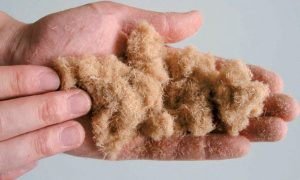
With the rapid development of domestic economy and urban construction and enlarged scale of industrial and civil construction
the cement to the technical disposal of building surfaces is much higher than before . on the basis of improving body’s engineering design
and instructing quality.Improving the surface quality, like roof of building and wall and floor, becomes a crucial task to the construction field
So on the basis of successfully developing polypropylene fiber mesh for concrete and polyester fiber for bitumen for bitumenand in view of some
technical problems existing in constructing field, our company sums up experiences and develops cracking resistance reinforced fiber for cement paint
(using in plastering) This fiber can improve quality of building’s wall and floor, and supply a new technical measure to reduce the surface crack,
so it has a good
economic value.
Technical Data
Raw Material Polypropylene Crack Elongation 20%±5%
Type Monofilament Density 0.91±0.01 % g/cm3
Fiber Dia 0.02-0.05±0.005mm Melting Point 160—170℃
Tensile Strength ≥450MPa Resistance to Acid, Alkali Strong
Size mm 12 Water Absorbency No
Reinforced Mortar Functions to Concrete
- Replace steel net (using in plastering)
- Prevent mortar split and crackle expansion
- Improve tendons protection
- Increase freezing & thawing resistance
- Increase seepage resistance
- Increase friction resistance
- Increase impact resistance and peeling resistance
- Resist to shrink & crack
The Feature of Polypropylene Monofiament
- No agglomeration and easily spread around in mortar or concrete. Guarantee the property of crack resistance effectively.
- Apply conveniently. No need to change the proportion of mortar, and just put the fibers into the mortar mixture and stir for a moment after adding water.
- Has fine economic property. The equivalent dia. of polypropylene monofilament is only φ 0.02mm,so the ratio of dia. And surface is high and on the basis of crack resistance, it can reduce the amount (o.6kg/m 3 ) and cut down the cost effectively.
- Be better to plaster. Because a great number of thin fibers spread into mortar evenly, so the plastering is much easier and this can improve the binding strength between surface and base.
- The fiber has stable chemical property, strong acid &alkali resistance, and can be used in any project.
Suitable Engineering for Polypropylene Monofilament
- Be suitable for the water–proof layer, floor, inner &outer wall of industrial and civil construction.
- Increase cracking resistance on the surface of industrial workshop, warehouse and parking lot.
- Be suitable for any mortar projects and fine aggregate concrete projects.
- Increase cracking & seepage resistance of the ground in natatorium, swimming pool, pond and ditch.
Applying Instruction
- Compound Amount: To resist the common cracks on surfaces, 0.6kg/m 3 fibers to cement paint are enough, and for reinforced application 0.9-.8kg/m 3 are enough.
- Stirring requirement: The proportion of cement, sand and aggregate is no need to be changed. Put cement, aggregate, additive and fiber together, then stir after adding enough water (Do not stir without water!) and time for stirring can be prolonged for 2~3 minutes in order to make the compound mix completely.
- Package: There are two specifications 0.6kg per bag and 0.9kg per bag.